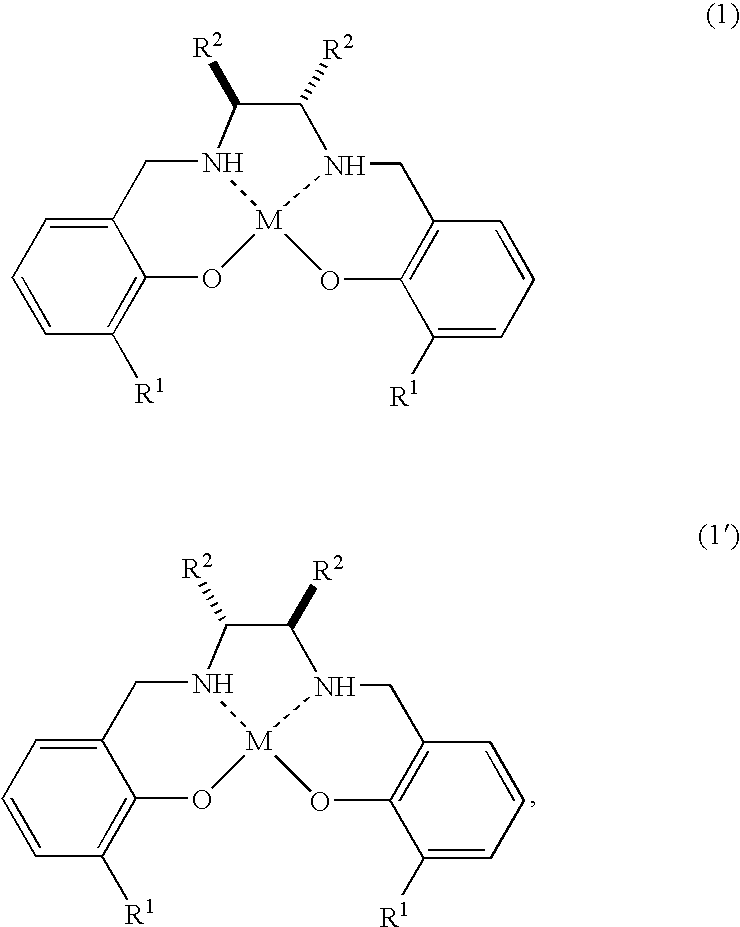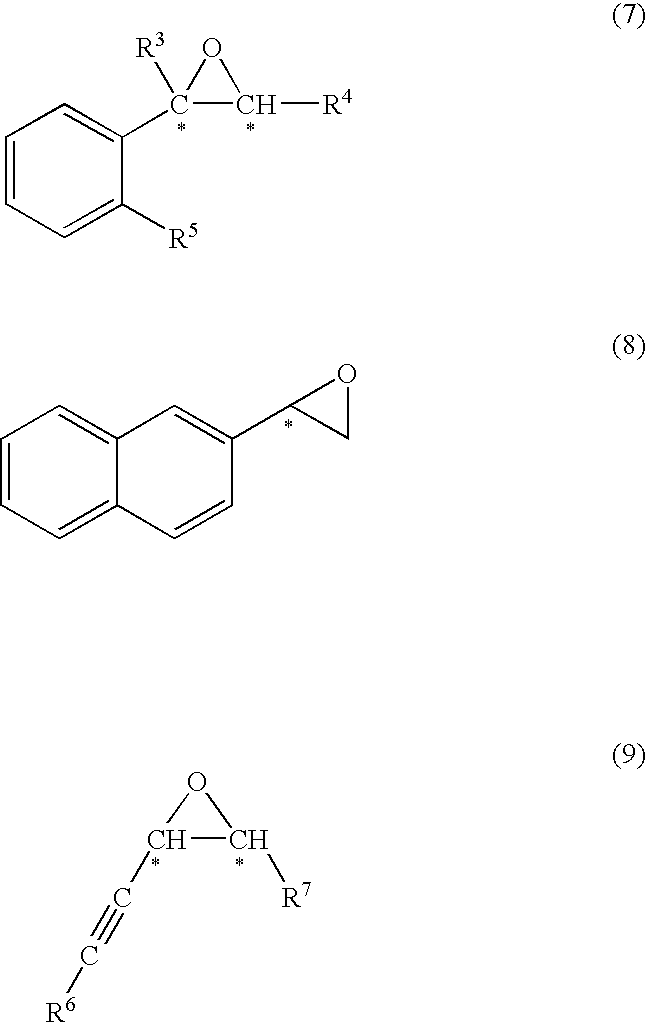Production method of optically active epoxy compound, complex used for the method and production method of the complex
a production method and epoxy compound technology, applied in the field of new optically active titanium complexes, can solve the problems of insufficient catalyst turnover, insufficient method applicability, and long time and high cost for complex synthesis, and achieve the effect of high enantioselectivity
- Summary
- Abstract
- Description
- Claims
- Application Information
AI Technical Summary
Benefits of technology
Problems solved by technology
Method used
Image
Examples
examples
[0076]Hereinafter, the present invention will be described in further detail based on examples to which the present invention is not limited.
[0077](Method A)
[0078]The preparation of a catalyst in the reaction system and the production method of optically active epoxy compound (Method A) are as follows. The salen ligand of formula (14′)
[0079]
wherein R means (R) of absolute configuration, was reduced with NaBH4 to synthesize the salan ligand of formula (13′)
[0080]
wherein R means (R) of absolute configuration. In a dichloromethane solution (0.5 mL) in which the salan ligand of formula (13′) (3.2 mg, 0.006 mmol) was dissolved, a dichloromethane solution in which Ti(Oi-Pr)4 (1.4 mg, 0.005 mmol) was dissolved was added and stirred at 25° C. for 1 hour. Thereafter, continuously without isolation of the optically active titanium salan complex, an unsaturated compound having carbon-carbon double bond (0.10 mmol), and then commercially available 30% aqueous hydrogen peroxide (0.11 mmol) were ...
examples 1 to 7
[0083]Examples in which a catalyst was prepared from the salan ligand of formula (13′) and Ti(Oi-Pr)4 in situ and an optically active epoxy compound was produced, are shown in Table 1. In Example 5, the used amount of the salan ligand and Ti(Oi-Pr)4 was altered, and the reaction was carried out similarly to Method A. In Examples 6 and 7, the reaction time was altered to 6 hours, and the reaction was carried out similarly to Method A.
[0084]
TABLE 1Catalyst (prepared inEnantiomersitu)Excess RateSubstrate*2SalanReactionProduct*2(% ee,(unsaturatedLigandTi(Oi-Pr)4OxidizingTime(epoxyYieldabsolutecompound)(mol %)*1(mol %)*1AgentSolvent(hour)compound)(%)configuration)Example 1Substrate 165AqueousDichloromethane9Product 18998, (1S, 2R)hydrogenperoxideExample 2Substrate 265AqueousDichloromethane9Product 26697, (5S, 6R)hydrogenperoxideExample 3Substrate 365AqueousDichloromethane9Product 38494, (2R, 3S)hydrogenperoxideExample 4Substrate 465AqueousDichloromethane9Product 46889, (S)hydrogenperoxid...
examples 8 to 14
[0088]Examples in which a catalyst was prepared from the salan ligand of formula (12′) and Ti(Oi-Pr)4 in situ and an optically active epoxy compound was produced, are shown in Table 2. In Example 12, the used amount of the salan ligand and Ti(Oi-Pr)4 was altered, and the reaction was carried out similarly to Method B. In Examples 13 and 14, the reaction time was altered to 6 hours, and the reaction was carried out similarly to Method B.
[0089]
TABLE 2Catalyst (prepared inEnantiomersitu)Excess RateSubstrate*2SalanReactionProduct*2(% ee,(unsaturatedLigandTi(Oi-Pr)4OxidizingTime(epoxyYieldabsolutecompound)(mol %)*1(mol %)*1AgentSolvent(hour)compound)(%)configuration)Example 8Substrate 165AqueousDichloromethane9Product 19398, (1S, 2R)hydrogenperoxideExample 9Substrate 265AqueousDichloromethane9Product 27898, (5S, 6R)hydrogenperoxideExample 10Substrate 365AqueousDichloromethane9Product 39296, (2R, 3S)hydrogenperoxideExample 11Substrate 465AqueousDichloromethane9Product 48087, (S)hydrogenpe...
PUM
| Property | Measurement | Unit |
|---|---|---|
| temperature | aaaaa | aaaaa |
| temperature | aaaaa | aaaaa |
| temperature | aaaaa | aaaaa |
Abstract
Description
Claims
Application Information
 Login to View More
Login to View More - R&D
- Intellectual Property
- Life Sciences
- Materials
- Tech Scout
- Unparalleled Data Quality
- Higher Quality Content
- 60% Fewer Hallucinations
Browse by: Latest US Patents, China's latest patents, Technical Efficacy Thesaurus, Application Domain, Technology Topic, Popular Technical Reports.
© 2025 PatSnap. All rights reserved.Legal|Privacy policy|Modern Slavery Act Transparency Statement|Sitemap|About US| Contact US: help@patsnap.com



